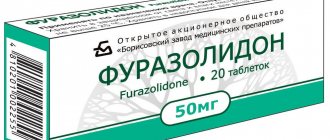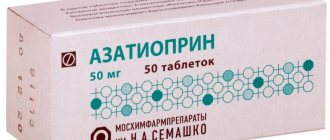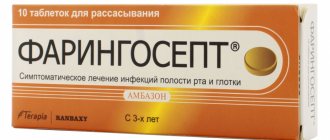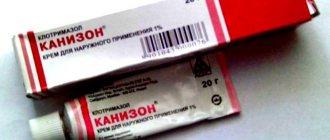Metronidazole is prescribed to treat diseases caused by bacteria and protozoa. The mechanism of action of the drug is based on the destruction of infectious agents in the body. It can be used in the treatment of pathologies of various organs. Used in childhood. Only a doctor can prescribe antimicrobial therapy.
The drug is on the list of the most effective medications according to the World Health Organization.
Compound
The product is available in different forms, all forms contain the active substance metronidazole .
The solution for infusion contains 5 mg of active substance.
Metronidazole tablets contain 0.25 g of active ingredient.
Vaginal suppositories with metronidazole contain 0.125 g, 0.25 g or 0.5 g of the active ingredient. It also contains additional ingredients - polyethylene oxide
1500 and polyethylene oxide 400.
Metronidazole vaginal gel contains 1 g of metronidazole, as well as additional components: carbomer , propylene glycol, disodium edetate, propyl parahydroxybenzoate, sodium hydroxide, water.
Metronidazole cream contains 10 mg of metronidazole, as well as additional components: synthetic olbrot, cetyl alcohol, sodium lauryl sulfate, glycerol , stearic acid, propyloxybenzoate, methyl oxybenzoate, water.
Metronidazole gel for external use contains 10 mg of active ingredient, as well as additional components: ethanol, disodium EDTA, methyl oxybenzoate, carboxypolymethylene 940, propylene glycol, triethanolamine, propyloxybenzoate, water.
Release form
The drug is produced in several forms. The medicine in the form of a solution for infusion is a clear liquid that has a greenish tint. Fits in 100 ml bottles, they are placed in a cardboard pack.
The tablets are contained in blister packs of 10 pieces. A pack can contain one, two or five cell packs.
Vaginal suppositories are torpedo-shaped and white or yellowish in color. There are 10 pieces in a cardboard pack.
The vaginal gel is contained in a 30 g tube; the kit includes a special applicator for vaginal administration.
Gel and cream for external use are also produced; these products are contained in 15 g tubes, packaged in cardboard packs.
The medicine is produced in the form of a suspension for oral administration; vaginal tablets Metronidazole, the drug Metronidazole Lect, etc. are also produced.
Dosage regimen for the intravenous form of the drug:
For the treatment of infectious diseases caused by anaerobic bacteria, adults and children over 12 years of age are prescribed the drug intravenously every 8 hours, 100 ml of a 0.5% solution (500 mg). The infusion is carried out at a rate of 5 ml/min.
The maximum daily dose for intravenous administration is 4 g. The course of infusion therapy is 7-10 days, if necessary - 2-3 weeks. For children under 12 years of age, the dose for intravenous administration is set at the rate of 7.5 mg/kg body weight (1.5 ml of 0.5% metronidazole solution) every 8 hours.
The drug is administered intravenously, slowly. Trichopolum is also prescribed orally in a single dose of 250-500 mg.
To prevent infections caused by anaerobic bacteria (before abdominal surgery, in obstetric and gynecological practice), the use of Trichopolum infusion solution should be started 5-10 minutes before surgery.
For adults and children over 12 years of age, the drug is administered in a dose of 500 mg (100 ml of 0.5% solution) slowly intravenously, the infusion is repeated after 8 hours. The drug is used prophylactically no more than 12 hours after surgery.
For children under 12 years of age, the dose for intravenous administration is set at the rate of 7.5 mg/kg body weight (1.5 ml of 0.5% metronidazole solution). Trichopolum is also prescribed orally.
Rules for administering the infusion solution
Trichopolum 0.5% solution for intravenous administration in 100 ml polyethylene bottles is ready for use. The solution remaining after administration should not be reused. If there are visible changes in the solution, the drug should not be used.
pharmachologic effect
Pharmacological group - antimicrobial medicine, a group of antibiotics with high anaerobic activity.
When using Metronidazole for treatment, it should be taken into account that this drug has an antimicrobial and antiprotozoal effect. Its mechanism of action is based on the biochemical reduction of the 5-nitro group of metronidazole by transport intracellular proteins of protozoa and anaerobic microorganisms.
Bacteria die due to the interaction of the reduced 5-nitro group of metronidazole with the DNA of microorganism cells and, as a consequence, inhibition of the synthesis of their nucleic acids.
The product is active against Gardnerella vaginalis , Trichomonas vaginalis , Lamblia spp. , Entamoeba histolytica , Giardia intestinalis , the active substance is also active against obligate anaerobes Bacteroides spp. , Prevotella , Veillonella spp. , Fusobacterium spp . and in relation to individual gram-positive microbes ( Clostridium spp. , Eubacter spp. , Peptostreptococcus spp. , Peptococcus spp. ).
If the drug is combined with amoxicillin , it is active against Helicobacter pylori .
At the same time, facultative anaerobes and aerobic microorganisms do not show sensitivity to metronidazole. But if mixed flora is present (that is, aerobes and anaerobes), it acts synergistically with antibiotics that are effective against ordinary aerobes.
The medicine helps to increase the sensitivity of neoplasms to radiation, stimulates reparative processes, and promotes the manifestation of disulfiram-like reactions.
Pharmacokinetics and pharmacodynamics
The drug label indicates that after administration of the drug intravaginally, systemic absorption of the active substance occurs. Approximately 56% is absorbed.
There is a twofold higher relative bioavailability of the product used in the form of a vaginal gel compared to vaginal tablets when using a single dose of 500 mg. The highest concentration when using vaginal gel is achieved 6-12 hours after use.
Metronidazole is less than 20% bound to blood proteins. The substance passes through the placental barrier, the BBB, and enters all tissues in the body. It is noted to be excreted in breast milk.
Metabolism takes place in the liver, excretion occurs mainly through the kidneys (approximately 60-80%, with about 20% excreted unchanged from the body). Another 6-15% is excreted from the body through the intestines.
Absorption and excretion
All dosage forms are well absorbed and have a systemic effect. The drug substance is distributed in the body, penetrates biological barriers and is distributed in different anatomical structures. Found in cerebrospinal fluid and amniotic fluid. The binding rate to blood proteins reaches thirty percent. The substance is converted in the liver (partially). A metabolite is formed that has a therapeutic effect. The drug is excreted mainly in the urine and slightly through the digestive system. Possible accumulation of the chemical compound upon repeated administration against the background of impaired renal tissue function.
Indications for use of Metronidazole
There are the following indications for the use of Metronidazole in suppositories:
- urethritis and trichomonas vaginitis (for men and women);
- amoebic dysentery;
- giardiasis;
- manifestation of anaerobic infections that develop due to the action of microorganisms sensitive to metronidazole;
- for the treatment of mixed severe aerobic-anaerobic infections;
- for the prevention of anaerobic infection in case of surgery;
- with alcoholism in chronic form.
Also prescribed for exacerbations of chronic gastritis ; for ulcers associated with Helicobacter pylori (combined with amoxicillin).
Metronidazole ointment and other forms of the drug are prescribed for the following diseases and conditions:
- acne vulgaris and rosacea , bacterial vaginosis (applied externally);
- wounds and trophic ulcers that do not heal for a long time;
- with demodicosis ;
- manifestation of protozoal infections (with extraintestinal amebiasis, intestinal amebiasis, amoebic liver abscess, giardiasis, trichomoniasis , trichomonas vaginitis, giardiasis, balantidiasis, cutaneous leishmaniasis , trichomonas urethritis, ureaplasma, cystitis );
- in case of infections caused by Bacteroides spp. (for infections of the central nervous system, for infections of the bones of the joints);
- for infections that are provoked by Clostridium spp., Peptococcus and Peptostreptococcus (for infections of the pelvic organs, abdominal cavity);
- pseudomembranous colitis (due to the use of antibiotics);
- ulcers and gastritis, which are associated with Helicobacter pylori;
- for the purpose of preventing complications after operations, in particular after interventions in the peri-rectal area, as well as after gynecological operations and appendectomy;
- as a radiosensitizing drug during radiation therapy for people suffering from tumors, if resistance is associated with hypoxia in tumor cells.
You can learn more about why the medicine helps, what Metronidazole in tablets and other forms helps with, from specialists.
What is Metronidazole for?
Taking Metronidazole tablets is indicated for the etiotropic treatment of infectious diseases caused by pathogenic microorganisms sensitive to the drug:
- Protozoal infectious diseases caused by protozoan single-celled microorganisms - trichomoniasis (inflammatory pathology of the urogenital tract), intestinal amebiasis (inflammation of the large intestine caused by pathogenic amoeba), extraintestinal amebiasis, including liver damage with the formation of abscesses in it (a limited cavity filled with pus).
- Infections caused by anaerobic bacteria, in particular bacteroides (Bacteroides fragilis, Bacteroides distasonis, Bacteroides ovatus, Bacteroides thetaiotaomicron, Bacteroides vulgatus) - infections of bone tissue, abscessing pathological processes of the structures of the central nervous system, meningitis (inflammation of the membranes of the brain and spinal cord), endocarditis ( infectious inflammation of the inner layer of the walls of the heart cavities), pneumonia (pneumonia), lung abscess, sepsis (blood poisoning).
- Infectious processes caused by anaerobic microorganisms clostridia and peptostreptococcus (Clostridium spp., Peptococcus niger and Peptostreptococcus) - pathology of the abdominal organs, including peritonitis, liver abscess, damage to the pelvic organs (endometritis with an inflammatory reaction of the inner layer of the uterine walls in women, ovarian abscess and fallopian tubes, infection of the vaginal vault).
- Complex therapy of gastric and duodenal ulcers caused by Helicobacter pylori.
- Prevention of infectious complications after colon surgery.
- Pseudomembranous colitis is a specific inflammation of the walls of the colon, which is often provoked by long-term use of antibiotics.
Metronidazole tablets are also used in the complex therapy of tumor diseases that require radiation.
Contraindications
The following contraindications are defined for the use of all forms of this medicine:
- high sensitivity to the drug;
- lesions of the central nervous system of an organic nature ( epilepsy , etc.);
- leukopenia (including a history);
- liver failure (the dosage must be accurate; large doses of the drug should not be used);
- breast-feeding.
Prescribe the drug with caution during pregnancy or in case of renal failure. In such conditions, the dosage should only be prescribed by a doctor.
Use of the drug TRICHOPOL® during pregnancy and breastfeeding
Metronidazole penetrates the placental barrier, therefore Trichopol® is contraindicated for use in the first trimester of pregnancy. The use of the drug in the second and third trimesters is possible only in cases where the expected benefit to the mother outweighs the potential risk to the fetus.
Since metronidazole is excreted in breast milk, reaching concentrations close to those in the blood plasma, if it is necessary to use Trichopolum during lactation, breastfeeding should be discontinued.
Side effects of Metronidazole
Side effects may develop while taking the drug:
- side effects in the functions of the gastrointestinal tract : nausea, vomiting, loss of appetite, diarrhea , constipation, manifestation of intestinal colic, dry mouth, pancreatitis , stomatitis ;
- functions of the nervous system : impaired coordination, dizziness , ataxia, disturbances of consciousness, depression , irritability, hallucinations, high excitability, weakness, convulsions, headaches, insomnia , peripheral neuropathy;
- allergic manifestations : skin rash, urticaria , skin hyperemia, fever, arthralgia;
- urinary system : polyuria, candidiasis , dysuria, urinary incontinence, cystitis, red-brown urine;
- local manifestations : thrombophlebitis ;
- other side effects : leukopenia, neutropenia, flattening of the T wave (manifested on the ECG).
Overdose
An overdose of Metronidazole Nycomed may cause symptoms such as nausea, vomiting, dizziness, headache, metallic taste in the mouth, and aversion to food. In rare cases, drowsiness, insomnia, depression of the central nervous system, dark urine color, and oliguria are possible. Ototoxic effects and epileptic seizures develop extremely rarely.
Since a specific antidote for metronidazole is unknown, in case of overdose, symptomatic and supportive therapy is recommended. Hemodialysis is an effective procedure for removing the drug from the blood, but it is rarely necessary.
Instructions for use of Metronidazole (Method and dosage)
The dosage and features of administration are determined by the form in which the patient is prescribed the drug.
Metronidazole tablets, instructions for use
The medicine in tablets should be taken orally, doing this during or after meals. No need to chew.
Patients with trichomoniasis are prescribed 250 mg twice a day, taken for 10 days. You can also use the drug at a dose of 400 mg twice a day for 5-8 days. During treatment, women should additionally use vaginal tablets or suppositories.
A repeated course of treatment or an increase in dose may be practiced. After the first course, it is important to take a break for about 1 month and conduct laboratory tests for control. As an alternative method of administration, 2 g of the drug is prescribed once to both sexual partners.
In the case of asymptomatic amebiasis (if a cyst is detected), adult patients are prescribed 500 mg of the drug 2-3 times a day, therapy lasts 5-7 days.
In the case of chronic amebiasis,
In the case of severe amoebic dysentery, a dose of 2.25 g per day is prescribed, divided into three doses, taken until the symptoms stop.
Patients with liver abscess are prescribed 2.5 g of the drug per day; it can be taken in one or 2-3 doses. Treatment lasts for 3-5 days, and a combination of metronidazole with tetracyclines .
For ulcerative stomatitis, it is recommended to take 500 mg of the drug twice a day, take 3-5 days.
In the case of pseudomembranous colitis - 500 mg tablets 3-4 times a day.
To eradicate Helicobacter pylory, take 500 mg 3 times a day, this should be done for seven days. Combination treatment is practiced, with amoxicillin and others.
In order to prevent infectious complications, 750-1500 mg of medication per day is prescribed before surgery, 3-4 days before the procedure. Also, a dose of 750 mg per day can be taken for 7 days after surgery.
To treat anaerobic infection, 1.5-2 g of Metronidazole or Metronidazole LekT is prescribed per day.
Metronidazole suppositories, instructions for use
Suppositories, vaginal gel, vaginal tablets are prescribed intravaginally in a dose of 500 mg, they should be administered once before bedtime or twice - in the morning and in the evening.
As a rule, treatment lasts for 10 days. Depending on the diagnosis or course of the disease, the dosage and duration of therapy should be adjusted by the doctor. During the period of using vaginal medications, you should refrain from sexual intercourse.
Metronidazole ointment, instructions for use
As a rule, ointment and gel should be applied topically and externally twice a day, the dosage is set on an individual basis. The skin should first be cleaned, the layer of product should be thin. If necessary, an occlusive dressing can be applied.
As a rule, treatment lasts from 3 to 9 weeks. You can alternate the use of gel and cream. The effect of treatment is observed after 3 weeks.
Metronidazole veterinary
In veterinary medicine it is used in the form of tablets and granulates. For animals, it is used orally to treat trichomoniasis in cattle, histomoniasis in ducks and geese, dysentery and balantidiasis in pigs.
Treatment in veterinary medicine is carried out according to the scheme prescribed by a specialist. For turkey poults and chickens, the dose is calculated at the rate of 10 mg per 1 kg of bird. The product should be given three times a day for 10 days. The veterinarian determines how to give the product to turkey poults or other birds in the first days of life.
For the treatment of trichomoniasis in cattle, the drug is prescribed at a dose of 10 mg per 1 kg of weight for 3-4 days. In veterinary medicine, there are certain treatment regimens that are used after being prescribed by a specialist.
Metronidazole IV is prescribed to children over 12 years of age and adults, the initial dose is 0.5-1 g. It is administered by drip, with the duration of infusions being about 40 minutes.
If the drug is well tolerated, the dropper is later administered as a stream. As a rule, treatment is carried out within 1 week. If there is such a need, the duration of treatment can be extended.
Interaction
You should know when using Metronidazole that this is a drug that interacts in a certain way with other drugs.
The medicine enhances the effect of indirect anticoagulants . As a result, the time for prothrombin formation increases.
When using this drug, ethanol .
When taking disulfiram , the patient may develop various neurological symptoms. It is important that at least two weeks pass between prescribing these drugs.
Before taking Metronidazole intravenously, it should be noted that this drug should not be mixed with other medications.
The metabolism of metronidazole is inhibited by cimetidine . As a result, the concentration of metronidazole in the blood increases, and the likelihood of adverse reactions increases.
With the simultaneous use of drugs that stimulate microsomal oxidation enzymes in the liver , the concentration of metronidazole in plasma may decrease.
When used at the same time as Li+ preparations, an increase in the concentration of lithium is possible, which leads to the manifestation of signs of intoxication.
non-depolarizing muscle relaxants should not be practiced .
The antimicrobial effect of metronidazole is stimulated by sulfonamides .
Pharmacokinetics
Suction
After taking the drug orally, metronidazole is quickly and almost completely absorbed from the gastrointestinal tract. Bioavailability is at least 80%. Cmax of metronidazole in blood plasma is achieved after 1-3 hours. Eating reduces the rate of absorption and Cmax of metronidazole in blood serum.
Distribution
The binding of metronidazole to plasma proteins is less than 20%.
Metronidazole penetrates into most tissues and body fluids, including lungs, kidneys, liver, skin, cerebrospinal fluid, brain, bile, saliva, amniotic fluid, abscess cavities, vaginal secretions, seminal fluid, breast milk, penetrates the BBB and the placental barrier. Vd in adults is about 0.55 l/kg, in newborns - 0.54-0.81 l/kg.
Metabolism
About 30-60% of metronidazole is metabolized in the liver by hydroxylation, oxidation and binding to glucuronic acid. The main metabolite (2-oxymetronidazole) also has antiprotozoal and antibacterial effects.
Removal
T1/2 with normal liver function averages 8 hours (from 6 hours to 12 hours).
Metronidazole is excreted by the kidneys - 60-80% (20% unchanged), through the intestines - 6-15%. The renal clearance of metronidazole is 10.2 ml/min.
Pharmacokinetics in special clinical situations
T1/2 for alcoholic liver damage is 18 hours (from 10 hours to 29 hours); in newborns born at a gestational age of 28-30 weeks - about 75 hours; 32-35 weeks - 35 hours, 36-40 weeks - 25 hours, respectively.
Metronidazole and its main metabolites are quickly removed from the blood during hemodialysis (T1/2 is reduced to 2.6 hours). During peritoneal dialysis they are excreted in small quantities.
In patients with impaired renal function, after repeated administration, accumulation of metronidazole in the blood serum is possible (therefore, in patients with severe renal failure, the frequency of dosing should be reduced).
In elderly patients, renal excretion of metronidazole is reduced.
special instructions
It should be borne in mind that Metronidazole is an antibiotic that cannot be combined with ethanol. Otherwise, serious side effects may occur.
Metronidazole should not be combined with amoxicillin when treating children and adolescents under 18 years of age.
If treatment is carried out over a long period of time, it is important to carefully monitor laboratory blood values.
In patients with leukopenia, the likelihood of using the drug for treatment depends on whether there is a risk of developing an infection.
It is important to immediately stop treatment if the patient experiences dizziness, ataxia, or worsening neurological status.
When taking the drug, a false positive Nelson test , which should be taken into account when using Metronidazole for thrush and other diseases.
It is important to abstain from sexual activity if trichomonas vaginitis and urethritis are being treated. It is very important to treat both partners at the same time. Treatment should not be suspended during menstruation.
When using the product externally, it should be noted that if it gets into the eyes, the gel or cream can cause lacrimation. If this happens, it is important to immediately rinse your eyes with plenty of water.
When used externally, it is important to apply the product completely to the entire area affected by the disease. The gel does not leave greasy stains on clothes and skin.
The use of this drug in gardening and in the vegetable garden is also practiced. Metronidazole is used for plants against late blight. It is also used for onions to protect the plant from onion flies.
Many specialists in the field of dermatology use Metronidazole for acne. Acne gel effectively relieves inflammation and prevents scarring. At the same time, it also affects the cause of the rash. However, only a doctor should prescribe a regimen for how to take any form of Metronidazole for acne. Sometimes the patient is also prescribed pills to eliminate problems in the body that cause acne.
Before starting to take the drug, patients are often interested in whether Metronidazole is an antibiotic or not. It should be borne in mind that this is an antibacterial agent, which is why these tablets and other forms of the drug should be prescribed only by a specialist after examination and tests.
Metronidazole analogs
Level 4 ATC code matches:
Batsimex
Ornisol
Ornidazole
Meratin
Ornidazole-Vero
Klion
Tinidazole
Metronidazole analogues are drugs that contain a similar active substance in the composition. Please note that replacement of the drug can only be done after approval by the doctor.
Analogues of the drug are the drugs Deflamon , Batsimex , Metrogyl , Metron , Metronidal , Rozex , Orvagil , Siptrogil , Trichopolum , Metronidazole-LekT, Trichosept, Metronidazole Nycomed , etc.
Metronidazole or Trichopolum - which is better?
Both drugs have the same mechanism of action on the body. Therefore, we can assume that Trichopolum and Metronidazole are one and the same.
Indications for use are also similar: drugs are prescribed for thrush and other diseases of the genitourinary system. What one or another medicine treats in gynecology is determined by a specialist, but, as a rule, these drugs are interchangeable.
Analogues of the drug
Metronidazole is the name of the active ingredient and trade name. You can purchase other medications based on this chemical compound at the pharmacy.
Popular analogues:
- Flagyl.
- Trichopolum.
- Klion.
Analogue
Analogues can be used with the permission of a doctor.
For children
The dosage and regimen of taking the drug for children should only be prescribed by a doctor. As a rule, children under 1 year of age are prescribed 125 mg per day, children 2-4 years old should receive 250 mg per day, children 5-8 years old should receive 375 mg per day.
Children over 8 years of age are prescribed 500 mg of the drug per day. Why tablets are prescribed, and whether it is advisable, depends on the diagnosis. Products for external use are prescribed to children after reaching 12 years of age.
Metronidazole and alcohol
When discussing the compatibility of this medicine with alcohol, it should be noted that you should under no circumstances take alcoholic beverages during treatment. Reviews indicate that this combination significantly increases the severity of side effects.
A person who has consumed even a small amount of alcohol during treatment with Metronidazole may experience a significant decrease in blood pressure . Therefore, when taking the drug for thrush and other diseases, you should abstain from alcohol.
Metronidazole reviews
There are often reviews on the Internet about Metronidazole tablets, which write both about the effectiveness of this drug and about certain concerns associated with taking the drug. In particular, more than one specialized forum contains information about side effects.
It is also noted that alcohol during treatment provokes the manifestation of serious negative actions. Reviews of Metronidazole suppositories indicate that when used correctly, they can completely cure many unpleasant diseases.
There is information that gel and ointment are effective if you need to get rid of acne. Reviews often write about what the drug treats and what the results of therapy are.
Dosage regimen for vaginal tablets:
For trichomonas vaginitis, the drug is prescribed 1 vaginal tablet per day for 7-10 days in combination with taking metronidazole tablets.
For nonspecific vaginitis and bacterial vaginosis, the drug is prescribed 1 vaginal tablet per day for 7 days, if necessary in combination with taking metronidazole tablets.
Treatment with metronidazole should not last more than 10 days and be repeated more than 2-3 times a year.
The vaginal tablet should be removed from the contour packaging, moistened with boiled cooled water and inserted deep into the vagina.
Metronidazole price, where to buy
The price of Metronidazole in tablets of 250 mg is on average 10 rubles per 10 pieces. Buy 250 mg tablets in a package of 20 pcs. You can get it for an average of 12-15 rubles per package. The cost of 500 mg tablets is approximately 80 rubles per pack of 20 pieces.
The price of Metronidazole suppositories in Russia is approximately 100 rubles per package. The price of the gel is on average 120 rubles per tube. Metronidazole suppositories, as well as cream and ointment, can be purchased at any pharmacy. The price of Metronidazole in Ukraine (Kyiv, Kharkov and other cities) is on average 25 hryvnia per package of 20 pcs. How much tablets cost in other packages depends on the manufacturer.
- Online pharmacies in RussiaRussia
- Online pharmacies in UkraineUkraine
- Online pharmacies in KazakhstanKazakhstan
ZdravCity
- Foam cleanser with metronidazole and herbs Epideril demodex bottle 150 mlKOSMOPHARM LLC RU
447 rub.order - Metronidazole tablets 250 mg 24 pcs. AO Update PFC
78 RUR order
- Metronidazole tablets 250 mg 40 pcs. Pharmstandard-Leksredstva OJSC
140 rub. order
- Metronidazole tab. 250mg No. 20Velfarm LLC
81 RUR order
- Metronidazole vaginal suppositories. 500 mg 10 pcs. LLC Avexima Siberia
RUB 192 order
Pharmacy Dialogue
- Metronidazole tablets 250 mg No. 24) Update PFK JSC
78 RUR order
- Metronidazole tablets 250 mg No. 20 Medisorb
36 RUR order
- Metronidazole tablets 250 mg No. 20BZMP
16 rub. order
show more
Pharmacy24
- Metronidazole Denta gel 20 g TOV "Arpimed", Republic of Virmenia
48 UAH.order - Metronidazole 0.5% 100 ml solution for infusion
11 UAH order
- Metronidazole-Darnitsa 5 mg/ml 100 ml No. 1 PrAT solution" Pharmaceutical company "Darnitsa", Ukraine
15 UAH order
- Metronidazole 0.5% 100 ml solution for infusion
20 UAH order
- Metronidazole 0.25g No. 20 tablets PAT "Lubnipharm", Ukraine
26 UAH order
PaniPharmacy
- Metronidazole tablets Metronidazole tablets 0.25g No. 20 Ukraine, Lubnyfarm PJSC
30 UAH order
- Metronidazole infusion Metronidazole infusion solution 0.5% 100ml Ukraine, Novofarm-Biosintez LLC
13 UAH order
- Metronidazole tablets Metronidazole tablets 0.25g No. 10 Ukraine, Lubnyfarm PJSC
16 UAH order
- Metronidazole infusion Metronidazole solution inf. 0.5% 100ml Ukraine, Darnitsa ChAO
17 UAH order
- Metronidazole infusion Metronidazole solution for infusion. 0.5% 100ml Ukraine, Infusion JSC
21 UAH order
show more
Storage conditions and price
Store out of the reach of children, in a dry place, protected from light, at a temperature of 15 to 25 °C. Shelf life: 3 years. Do not use after expiration date. Metronidazole is a prescription drug sold over the counter.
How much Metronidazole costs depends on the form of release and the amount of active ingredient. The price for a package of suppositories (10 pcs.) ranges from 66 rubles to 200 rubles.
Analogues of the drug
Metronidazole The modern pharmacological industry has developed several analogues of metronidazole, the composition of which is practically no different from the original. Metronidazole suppositories, just like their analogues, have their own side effects.
The main analogues include:
- Trihapol;
- Metromicon-Neo;
- Nikamed;
- Metrophyte;
- Miconazole;
- Klean;
- Metrogil;
- Flagin.
Metromicon-Neo is a combined substance analogous to Metronidazole-Pharmex suppositories, the composition of which is very similar to honey. Metromicon-Neo is an antiprotozoal and antiparasitic agent that is prescribed for infectious diseases of the genital organs.
If the doctor prescribes weaker analogues, he recommends taking iodoxide as a supplement.
But to be on the safe side, iodoxide is prescribed by a specialized doctor when taking metronidazole and its strong analogues. After all, iodoxide is an antimicrobial drug that effectively destroys fungus or microbes in the body.
How much does this medication cost? The drug Metronidazole costs an average of 200 rubles. But you can find its analogues with similar composition and indications, but at a lower price.
But it is not recommended to make a decision on purchasing analogues on your own.
After all, any medicinal substance that includes metronidazole is synthetic, and therefore can cause various allergic reactions. Therefore, before purchasing, you need to consult with a specialized doctor who will select the most effective and safe drug.










